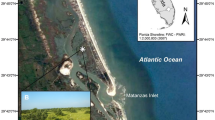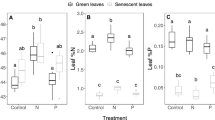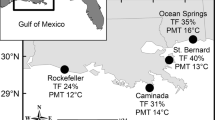Abstract
Climate change is a primary driver of tropical mangroves colonizing temperate salt marshes in the Gulf of Mexico. Studies indicate that threshold temperatures of adult and sapling Avicennia germinans survival range from −7 to −10 °C and survival can depend on life history stage during a freeze event. We performed a growth chamber study to explore responses to varying freezing temperature regimes when produced at two different latitudes with varying salinity and nutrient conditions. Propagules were collected from Corpus Christi and South Padre Island, Texas. In Corpus Christi Bay, propagules were harvested from fertilized maternal shrubs (nitrogen, phosphorus, and controls) in an ongoing fertilization experiment (2017 to present). A 2-h hard freeze treatment (−8 °C), resulted in 20% survival across latitude and nutrient treatments. The lower latitude propagules, which were harvested from the hypersaline South Padre Island A. germinans, had higher survival rates after –2 °C exposure, grew significantly taller as seedlings over 20 weeks, and produced more leaves after −8 °C exposure. Propagules from nitrogen-treated shrubs grew taller following −2 °C exposure. In all treatments, propagule weight was a significant covariate predictor of seedling height and leaf production. Avicennia germinans populations may not be decimated by a single −8 °C freeze, and populations could possibly experience rapid recruitment from surviving propagules after a freeze, leading to local adaptation. Growth benefits from fertilized parent plants indicate that propagules from high nutrient areas may be “hotspots” of future A. germinans expansion.



Similar content being viewed by others
References
Alldred, M., A. Liberti, and S.B. Baines. 2017. Impact of salinity and nutrients on salt marsh stability. Ecosphere 8(11): e02010. https://doi.org/10.1002/ecs2.2010.
Armitage, A.R., W.E. Highfield, S.D. Brody, and P. Louchouarn. 2015. The contribution of mangrove expansion to salt marsh loss on the Texas Gulf Coast. PLoS ONE 10: 1–17.
Bardou, R., J.D. Parker, I.C. Feller, and K.C. Cavanaugh. 2020. Variability in the fundamental versus realized niches of North American mangroves. Journal of Biogeography 48: 160–175.
Breshears, D.D., O.B. Myers, C.W. Meyer, F.J. Barnes, C.B. Zou, C.D. Allen, N.G. McDowell, and W.T. Pockman. 2009. Research communications research communications Tree die-off in response to global change-type drought: Mortality insights from a decade of plant water potential measurements. Frontiers in Ecology and the Environment 7: 185–189.
Cavanaugh, K.C., E.M. Dangremond, C.L. Doughty, A. Park Williams, J.D. Parker, M.A. Hayes, W. Rodriguez, and I.C. Feller. 2019. Climate-driven regime shifts in a mangrove–salt marsh ecotone over the past 250 years. Proceedings of the National Academy of Sciences United States of America 116: 21602–21608.
Cavanaugh, K.C., J.R. Kellner, A.J. Forde, D.S. Gruner, J.D. Parker, W. Rodriguez, and I.C. Feller. 2014. Poleward expansion of mangroves is a threshold response to decreased frequency of extreme cold events. Proceedings of the National Academy of Sciences 111: 723–727.
Cavanaugh, K.C., M.J. Osland, R. Bardou, G. Hinojosa-Arango, J.M. López-Vivas, J.D. Parker, and A.S. Rovai. 2018. Sensitivity of mangrove range limits to climate variability. Global Ecology and Biogeography 27: 925–935.
Cavanaugh, K.C., J.D. Parker, S.C. Cook-Patton, I.C. Feller, A.P. Williams, and J.R. Kellner. 2015. Integrating physiological threshold experiments with climate modeling to project mangrove species’ range expansion. Global Change Biology 21: 1928–1938.
Cleland, E.E., I. Chuine, A. Menzel, H.A. Mooney, and M.D. Schwartz. 2007. Shifting plant phenology in response to global change. Trends in Ecology & Evolution 22: 357–365.
Coldren, G.A., and C.E. Proffitt. 2017. Mangrove seedling freeze tolerance depends on salt marsh presence, species, salinity, and age. Hydrobiologia 803: 159–171.
Comeaux, R.S., M.A. Allison, and T.S. Bianchi. 2011. Mangrove expansion in the Gulf of Mexico with climate change: Implications for wetland health and resistance to rising sea levels. Estuarine, Coastal and Shelf Science 96: 81–95.
Cook-Patton, S.C., M. Lehmann, and J.D. Parker. 2015. Convergence of three mangrove species towards freeze-tolerant phenotypes at an expanding range edge. Functional Ecology 29: 1332–2134.
Costanza, R., R. de Groot, P. Sutton, S. van der Ploeg, S.J. Anderson, I. Kubiszewski, S. Farber, and R.K. Turner. 2014. Changes in the global value of ecosystem services. Global Environmental Change 26: 152–158.
Dangremond, E.M., L.T. Simpson, T.Z. Osborne, and I.C. Feller. 2019. Nitrogen enrichment accelerates mangrove range expansion in the temperate–tropical ecotone. Ecosystems 23: 703–714.
Darby, F.A., and R.E. Turner. 2008. Below- and aboveground biomass of Spartina alterniflora: Response to nutrient addition in a Louisiana salt marsh. Estuaries and Coasts 31: 326–334.
Davy, A.J., S.M. Noble, and R.P. Oliver. 1990. Genetic variation and adaptation to flooding in plants. Aquatic Botany 38: 91–108.
Devaney, J.L., M. Lehmann, I.C. Feller, and J.D. Parker. 2017. Mangrove microclimates alter seedling dynamics at the range edge. Ecology 98: 2513–2520.
Devaney, J.L., J. Pullen, I.C. Feller, and J.D. Parker. 2020. Low humidity and hypersalinity reduce cold tolerance in mangroves. Estuarine, Coastal and Shelf Science 248: 107015.
Diskin, M.S., and D.L. Smee. 2017. Effects of black mangrove Avicennia germinans expansion on salt marsh nekton assemblages before and after a flood. Hydrobiologia 803: 283–294.
Espeland, E.K., and K.J. Rice. 2007. Facilitation across stress gradients: The importance of local adaptations. Ecology 88: 2404–2409.
Feher, L.C., M.J. Osland, K.T. Griffith, J.B. Grace, R.J. Howard, C.L. Stagg, N.M. Enwright, K.W. Krauss, C.A. Gabler, R.H. Day, and K. Rogers. 2017. Linear and nonlinear effects of temperature and precipitation on ecosystem properties in tidal saline wetlands. Ecosphere 8 (10): e01956.
Feller, I.C. 1995. Effects of nutrient enrichment on growth and herbivory of dwarf red mangrove (Rhizophora mangle). Ecological Monographs 65: 477–505.
Feller, I.C. 2002. The role of herbivory by wood-boring insects in mangrove ecosystems in Belize. Oikos 97: 167–176.
Feller, I.C., M.C. Ball, J.I. Ellis, C.E. Lovelock, and R. Reef. 2017a. Interactive effects of climate and nutrient enrichment on patterns of herbivory by different feeding guilds in mangrove forests. Global Ecology and Biogeography 26: 1326–1338.
Feller, I.C., E.M. Dangremond, D.J. Devlin, C.E. Lovelock, C.E. Proffitt, and W. Rodriguez. 2015. Nutrient enrichment intensifies hurricane impact in scrub mangrove ecosystems in the Indian River Lagoon, Florida, USA. Ecology 96: 2960–2972.
Feller, I.C., D.A. Friess, K.W. Krauss, and R.R. Lewis. 2017b. The state of the world’s mangroves in the 21st century under climate change. Hydrobiologia 803: 1–12.
Feller, I.C., K.L. McKee, D.F. Whigham, and J.P. O’Neill. 2003a. Nitrogen vs. phosphorus limitation across an ecotonal gradient in a mangrove forest. Biogeochemistry 62: 145–175.
Feller, I.C., D.F. Whigham, K.L. McKee, and C.E. Lovelock. 2003b. Nitrogen limitation of growth and nutrient dynamics in a disturbed mangrove forest, Indian River Lagoon, Florida. Oecologia 134: 405–414.
Gabler, C.A., M.J. Osland, J.B. Grace, C.L. Stagg, R.H. Day, S.B. Hartley, N.M. Enwright, A.S. From, M.L. McCoy, and J.L. McLeod. 2017. Macroclimatic change expected to transform coastal wetland ecosystems this century. Nature Clinical Practice Endocrinology & Metabolism 7: 142–147.
Hayes, M.A., A.C. Shor, A. Jesse, C. Miller, J.P. Kennedy, and I.C. Feller. 2020. The role of glycine betaine in range expansions; protecting mangroves against extreme freeze events. Journal of Ecology 108: 61–69.
Jiang, X., and Z.L. Yang. 2012. Projected changes of temperature and precipitation in Texas from downscaled global climate models. Climate Research 53: 229–244.
Kelleway, J.J., K.C. Cavanaugh, K. Rogers, I.C. Feller, E. Ens, C. Doughty, and N. Saintilan. 2017. Review of the ecosystem service implications of mangrove encroachment into salt marshes. Global Change Biology 23: 3967–3983.
Kennedy, J.P., H. Craig, A. Jara-Cavieres, A. Lundy, R.F. Preziosi, and J.K. Rowntree. 2020. Multiplex microsatellite PCR panels for the neotropical red mangrove, Rhizophora mangle: Combining efforts towards a cost-effective and modifiable tool to better inform conservation and management. Conservation Genetics Resources 12: 503–513.
Klanderud, K. 2005. Climate change effects on species interactions in an alpine plant community. Journal of Ecology 93(1): 127–137. https://doi.org/10.1111/j.1365-2745.2004.00944.x.
Kowalski, J.L., H.R. DeYoe, G.H. Boza, D.L. Hockaday, and P.V. Zimba. 2018. A comparison of salinity effects from Hurricanes Dolly (2008) and Alex (2010) in a Texas lagoon system. Journal of Coastal Research 34: 1429–1438.
Leonardi, N., N.K. Ganju, and S. Fagherazzi. 2015. A linear relationship between wave power and erosion determines salt-marsh resilience to violent storms and hurricanes. Proceedings of the National Academy of Sciences 113: 64–68.
Lovelock, C.E., and C.M. Duarte. 2019. Dimensions of blue carbon and emerging perspectives. Biology Letters 15: 1–5.
Madrid, E.N., A.R. Armitage, and J. Lopez-Portillo. 2014. Avicennia germinans (black mangrove) vessel architecture is linked to chilling and salinity tolerance in the Gulf of Mexico. Frontiers in Plant Science 5: 1–9.
Markley, J.L., C. McMillan, and G.A. Thompson. 1982. Latitudinal differentiation in response to chilling temperatures among populations of three mangroves, Avicennia germinans, Laguncularia racemosa, and Rhizophora mangle, from the western tropical Atlantic and Pacific Panama. Canadian Journal of Botany 60: 2704–2715.
Mendelssohn, I.A., M.R. Byrnes, R.T. Kneib, and B.A. Vittor. 2017. Coastal habitats of the Gulf of Mexico. In Habitats and Biota of the Gulf of Mexico: Before the Deepwater Horizon Oil Spill: Volume 1: Water Quality, Sediments, Sediment Contaminants, Oil and Gas Seeps, Coastal Habitats, Offshore Plankton and Benthos, and Shellfish, ed. C.H. Ward. New York, NY: Springer New York.
Osland, M.J., R.H. Day, A.S. From, M.L. McCoy, J.L. McLeod, and J.J. Kelleway. 2015. Life stage influences the resistance and resilience of black mangrove forests to winter climate extremes. Ecosphere 6: 1–15.
Osland, M.J., R.H. Day, C.T. Hall, M.D. Brumfield, J.L. Dugas, and W.R. Jones. 2017. Mangrove expansion and contraction at a poleward range limit: Climate extremes and land-ocean temperature gradients. Ecology 98 (1): 125–137.
Osland, M.J., R.H. Day, C.T. Hall, L.C. Feher, A.R. Armitage, J. Cebrian, K.H. Dunton, A.R. Hughes, D.A. Kaplan, A.K. Langston, A. Macy, C.A. Weaver, G.H. Anderson, K. Cummins, I.C. Feller, and C.M. Snyder. 2019. Temperature thresholds for black mangrove (Avicennia germinans) freeze damage, mortality and recovery in North America: Refining tipping points for range expansion in a warming climate. Journal of Ecology 108: 654–665.
Peng, D., H. Guo, A.R. Armitage, and S.C. Pennings. 2021. Competition and abiotic stress affect the size of mangroves near their geographic range limit. Journal of Plant Ecology rtab079.
Pickens, C.N., and M.W. Hester. 2011. Temperature tolerance of early life history stages of black mangrove Avicennia germinans: Implications for range expansion. Estuaries and Coasts 34: 824–830.
Pickens, C.N., T.M. Sloey, and M.W. Hester. 2019. Influence of salt marsh canopy on black mangrove (Avicennia germinans) survival and establishment at its northern latitudinal limit. Hydrobbiologia 826: 195–208.
Proffitt, C.E., and S.E. Travis. 2010. Red mangrove seedling survival, growth, and reproduction: Effects of environment and maternal genotype. Estuaries and Coasts 33: 890–901.
Ratajczak, Z., J.B. Nippert, and S.L. Collins. 2012. Woody encroachment decreases diversity across North American grasslands and savannas. Ecology 93: 697–703.
Reef, R., I.C. Feller, and C.E. Lovelock. 2010. Nutrition of mangroves. Tree Physiology 30: 1148–1160.
Sandoval-Castro, E., R.S. Dodd, R. Riosmena-Rodriǵuez, L.M. Enriq́uez-Paredes, C. Tovilla-Hernańdez, J.M. Loṕez-Vivas, B. Aguilar-May, and R. Munĩz-Salazar. 2014. Post-glacial expansion and population genetic divergence of Mangrove Species Avicennia germinans (L.) stearn and Rhizophora mangle L. along the Mexican coast. PLoS One 9.
Sherrod, C.L., and C. McMillan. 1985. The distributional history and ecology of mangrove vegetation along the northern Gulf of Mexico coastal region. Contributions in Marine Science 28: 129–140.
Smee, D.L., J.A. Sanchez, M. Diskin, and C. Trettin. 2017. Mangrove expansion into salt marshes alters associated faunal communities. Estuarine, Coastal and Shelf Science 187: 306–313.
Sousa, A.I., A.I. Lillebø, M.A. Pardal, and I. Caçador. 2010. Productivity and nutrient cycling in salt marshes: Contribution to ecosystem health. Estuarine, Coastal and Shelf Science 87: 640–646.
Stuart, S.A., B. Choat, K.C. Martin, N.M. Holbrook, and M.C. Ball. 2006. The role of freezing in setting the latitudinal limits of mangrove forests. New Phytologist 173: 576–583.
Weaver, C.A., and A.R. Armitage. 2018. Nutrient enrichment shifts mangrove height distribution: implications for coastal woody encroachment. PLoS One 13.
Wetz, M.S., K.C. Hayes, K.V.B. Fisher, L. Price, and B. Sterba-Boatwright. 2016. Water quality dynamics in an urbanizing subtropical estuary (Oso Bay, Texas). Marine Pollution Bulletin 104: 44–53.
Withers, K., and J.W. Tunnell, Jr. 1998. Identification of tidal flat alterations and determination of effects on biological productivity of these habitats within the coastal bend (Corpus Christi, Texas). Coastal Bend Bays & Estuaries Program (26).
Author information
Authors and Affiliations
Corresponding author
Additional information
Communicated by Dan Friess
Supplementary Information
Below is the link to the electronic supplementary material.
Rights and permissions
Springer Nature or its licensor holds exclusive rights to this article under a publishing agreement with the author(s) or other rightsholder(s); author self-archiving of the accepted manuscript version of this article is solely governed by the terms of such publishing agreement and applicable law.
About this article
Cite this article
Hoffman, S.E., Devlin, D.J. & Proffitt, C.E. Maternal Nutrient History Enhances Black Mangrove (Avicennia germinans) Seedling Growth After Propagules Experience a Hard Freeze. Estuaries and Coasts 45, 2534–2542 (2022). https://doi.org/10.1007/s12237-022-01108-3
Received:
Revised:
Accepted:
Published:
Issue Date:
DOI: https://doi.org/10.1007/s12237-022-01108-3




